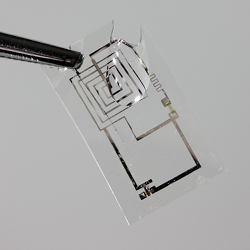
Materials science researchers have invented biodegradable chips that dissolve in water and vanish inside the body. The innovation could lead to a new design paradigm for implantable electronic devices, environmental monitors, and consumer devices that the scientists call "transient electronics." In their September 28 Science paper, "A Physically Transient Form of Silicon Electronics," the researchers, who are from The University of Illinois, Tufts University, and Northwestern University, say their chips can dissolve in hours, weeks, months, or years.
John A. Rogers, Professor of Materials Science and Engineering Professor of Chemistry at the University of Illinois, Urbana-Champaign, says the work "came out of necessity" after a decade of seeking ways to make electronics the human body could resorb. "The challenge has been how to go from brittle wafers to something that naturally integrates with the soft curvilinear body," he says. "So we’ve been working with a number of materials and manufacturing challenges to bridge that gap in mechanics and form." Previously he created elastic devices that can be woven into fabrics and put on skin, but long-term biocompatibility has been a persistent barrier. "We threw up our hands and said, ‘What if we just avoided the problem entirely by making devices simply disappear?’ This broader notion of temporal transience could be a more powerful concept."
Vanishing chips require certain constraints–materials that serve as a substrate, an encapsulation layer, conductor, dielectric, and semiconductor. The researchers chose magnesium oxide and very thin sheets of silicon enveloped in silk. Metal oxide was appealing because it is a nutritional supplement, and silicon is the backbone of nearly all commercial integrated circuits. The researchers found the silicon, at 10s of nanometers wide, could still support components, and even a 64-pixel digital camera. The silk determines the time to disappear because its protein solubility in water can be "programmed" by controlling its crystallinity. (Here’s a video of the device dissolving as liquid drops off a leak.)
Although building a soluble test microprocessor required tradeoffs on performance and neither its switching speeds nor densities of integration are state-of-the-art, Rogers notes "a lot of low-hanging fruit in the implantable device space doesn’t involve pushing the performance limits, but exploits this unique transient characteristic. We’re focusing on that rather than bleeding-edge electrical performance."
In the medical application arena, Rogers’ team demonstrated chips that elevate temperature five degrees on wounds in mice. Such thermal therapy could kill antibiotic-resistant bacteria, promote healing, and the chip could disappear after two weeks. For rehabilitation, a chip could apply voltages to stimulate contractions so that muscles autonomously exercise. Then the chip would vanish. Similarly, a device wrapped around a bone fracture could facilitate healing with electrode stimulation.
In consumer applications, disintegrating components of smartphones could render them more environmentally friendly. Eventually, the entire phone could be transient, says Rogers. And for a chemical or oil spill, an airplane could drop hundreds of thousands of distributed sensing devices to monitor the contamination’s size locally. Transient solar cells would power the wireless transmission of data those sensors recorded, and disintegrate after the spill was contained.
Fiorenzo Omenetto, a professor of biomedical engineering who lead the Tufts University team, says the paper shows that implantable vanishing devices caused lowed immunogenic response and were not rejected. Nor did they generate enough heat to be of concern. The main challenge is how best to power the devices when they become more complex, Omenetto says. "We’ll have to be clever in how to transfer power wirelessly, or how to make new generations of batteries," he says. Thermal therapy for wounds is a realistic application that is ready to be developed, he says, "but what stands in between is the regulatory path."
Rogers says the University of Illinois has partnered with an advanced silicon foundry to advance the widespread use of transient electronics, and to figure out how to leverage the manufacturing structure already in place for conventional wafer-based integrated circuits, which he says is a tremendously powerful route to low-cost, high-volume high functionality. "If we had to reinvent that, it would be a daunting proposition to get our chip out of our lab and into the real world," he says.
Based in Manhattan, Karen A. Frenkel is a freelance writer and editor specializing in science and technology.



Join the Discussion (0)
Become a Member or Sign In to Post a Comment